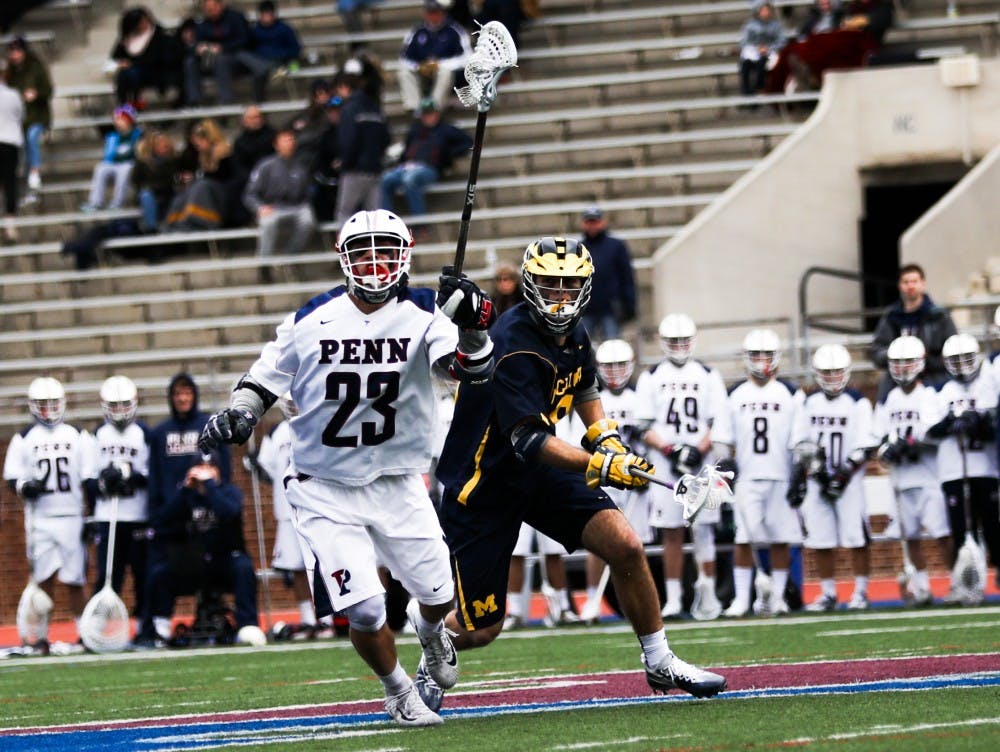For Penn men's lacrosse, the game is always changing.
There has been chatter within the men’s lacrosse community that the NCAA is interested in implementing a visible 60-second shot clock in hopes of speeding up the game.
This past fall, the NCAA men’s lacrosse rules committee requested that teams use a visible shot clock during pre-season competitions. The 60-second timer is set to start once possession is established, which includes the 30 seconds that teams have to clear the ball into the attack area. In other words, this would be an automatic shot clock, which is what the women in the NCAA play with.
Men’s collegiate lacrosse currently operates under a system in which a 30-second countdown is administered when a referee deems that a team is stalling. Under this rule, consistency and accuracy of the implementation of the shot clock are questionable and prone to human error.
Allegedly, a shot clock is coming full time next season, and Penn coach Mike Murphy believes this will undeniably speed up the game.
“There will be more shots, more goals, more changes in possession, and more faceoffs. It simply increases all these elements as well as the speed of the game,” Murphy said.
Regardless of potential changes, it is still imperative that, with the current shot clock, teams place the utmost importance on possession and putting pressure on the cage.
Quakers' standout midfielder Tyler Dunn likes the shot clock because it increases the pace of play, creates early offensive opportunities, and makes the game more exciting.
RELATED:
With key pieces returning, Penn men's lacrosse's offense is loaded with talent
After injuries ended his football career, junior Alex Andersen walks on to Penn men's lacrosse
“We play with a settled offense, but we still like to get shots off early," Dunn said. "Typically, we try to get a good look at goal within the first 30 seconds of possession.”
On the defensive end of the field, senior Connor Keating does not believe that the shot clock will affect the style of play on defense.
“We cannot deviate from our game plan purely based off the shot clock,” Keating maintained.
Murphy believes that the shot clock can be the deciding factor in a tight game.
“The shot clock is probably the most disproportionately important part of our game," he said. "For example, in the Penn State game, we lost around 90 percent of the faceoffs, and so when the other team has that many more possessions than we do, it makes it very hard to win a game.”
The primary faceoff man for the Red and Blue is senior Chris Santangelo. Last season, Santangelo had a faceoff win percentage of 52.8, the highest of his collegiate career. In his final season, winning as many faceoffs as possible is crucial.
“Every faceoff won is not only one that is won for Penn, but one that is taken away from the opposing team,” Santangelo explained.
When questioned on his mentality and technique going in to each faceoff, Santangelo responded that he likes to keep it simple.
“I get down on one knee, take a deep breath, clear my mind, put my right hand down, punch my left, and try as hard as I can to leverage the other guy. After that it comes down to hand speed, form, and core strength.”
For Penn, getting these technical aspects down to a science will be important going into competitive and cutthroat Ivy League play — and hopefully beyond.



